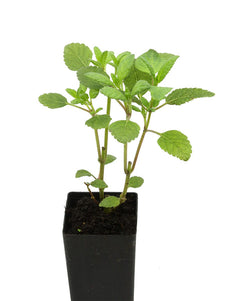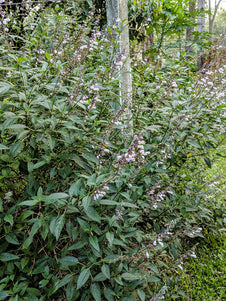









Salvia waverly
Salvia waverly

- In stock, ready to ship
- Inventory on the way

Usually available: All year
Life cycle: Perennial
Height: 1.2m
Position: Full sun
Soil preference: Well drained
This is how we pack and send your Herb Plants to all states except TAS & WA
You will receive
- 1 Salvia Waverley Herb Plant in a 50 X 75mm tube - General growing instructions
All of our Herb Plants are grown organically with certified organic potting mixes and fertilizers
Botanical Name: Salvia 'Waverly'
Salvia Waverly is a fast growing, continual flowering plant of American origin. It reaches 1.2 meter high and a 1.4 meter spread on a medium sized, reasonably tidy bush. The grey-green leaves are deeply veined, elongated to a point and take on a leathery appearance. The stems extend up from the base and arch in a fountain like manner, before developing the long purple flower stalks. The flowers are white, with a mauve tinge and the calyces are a deep purple to pink.
Waverly is generally described as a great all-rounder for the garden – easy to grow and easy to maintain. It provides a ready supply of cut flowers and acts as a butterfly and bee attractant. As a garden plant is provides for a nice mass planting or backdrop for lower border plants, mixing well with the Heliotropes and roses. When trying to establish a new garden, Waverly does a great job because it is such a fast grower. When mixed with red leaved plants, like Coleus, the flowers and calyces are set off very nicely.
Growing Conditions
Waverly is well suited to hot and humid conditions. Despite this recommendation, the plant is actually semi-drought tolerant once established and may also do well in coastal and dry gardens. The plant still requires water during hot periods. This salvia prefers moist, enriched soil but will grow in most free draining soils. Full sun is ideal, although it will grow in partial shade. During frosty periods the plant may die down, but will bounce back later.
The plant is continually in bloom and this makes it difficult to cut back. Generally, it should only be trimmed to shape in winter and not more than half the plant. It is generally quite a tidy plant and has a rounded appearance. In less than ideal conditions the plant will be smaller and it is also known to do well in large pots.
The salvia family has over 900 members with an extensive history as culinary, medicinal and ornamental plants. Ornamental salvias have become collectors’ items, as gardeners try to find a place in their garden for each and every one. There are salvias that will suit every type of soil and climate. More information on the Salvia genus and Common Sage (Salvia officinalis) may be found on our Common Sage page.
All information provided on this website is for informational purposes only. Please seek professional advice before commencing any treatment.





